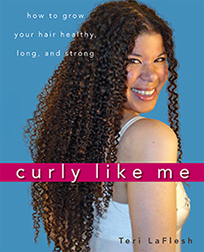
Available now!
Curly Like Me, the off-the-grid, do-it yourself owner's manual for tightly curly hair, is ready for ordering. Grab your copy today!

Every purchase made from
this site (through Amazon)
helps support it — and it
doesn't cost you anything
extra.
|
|
In the ingredient descriptions: Good means that I like to see this in a product's list of ingredients. Okay means this product appears safe for a curly person like me to use. Caution means that this ingredient may not be good in some hair care products, or for some people. Avoid means this ingredient may hurt your hair. If you see this ingredient in a hair product, it's best to put it down and walk away.
|
|
| |
Keratin
(aka Keratin protein; Keratin polypeptides; Protein)
Okay
Keratin is a type of protein found in hair, wool, feathers and horn, fingernails and skin (skin gives a softer type of keratin, with a smaller keratin content). Depending on where the keratin has come from, they are each made of different types of amino acids. Some types of keratin are better at conditioning than others ( My sources don’t list which types of Keratin are better at conditioning than other types, so I’m still looking into this—T). Keratin is known for having great coating abilities. This means they don’t wash out of hair as easily as silk amino acids. Also, they don’t flake on your hair the way collagen proteins can [Hunting (Conditioning) pages 349-352 & 256-257].
Since hair is mostly made of the protein Keratin, many products claim that because they have Keratin in them, they can repair or heal your hair. This is not true. For one thing, Keratin doesn't cling well to hair, even in products that are left in your hair. However, if the Keratin is broken down so it clings better, it's no longer Keratin anyway( it's now chains of amino acids instead). All that being said, at best, all Keratin can do is condition your hair. It can not repair it [Begoun (Hair-Care) pg.83].
See also:
Keratin Amino Acids Protein
Source(s):
Hunting Begoun Schueller
|
Keratin amino acids
Caution
Used for conditioning, moisturizing, known to make hair glossy, give it more body, and also for its marketing appeal (natural ingredient as well as hair is made from this). It’s a strong humectant, and pulls water into the hair. This is made from a mixture of amino acids, the most common in this mixture are Glutamic acid, Serine, Proline, Arginine, Threonine, and Aspartic acid. Cystine is often removed because it tends to fall to the bottom of the product and then starts to smell over time.
Keratin is broken down into amino acids using Hydrochloric acid. After the Keratin is broken down with Hydrochloric acid, it is neutralized with Sodium hydroxide. The acid and the base make a salt. Therefore, Keratin amino acids may have an extremely high salt content that may contain up to 50% salt. It’s sold as a brown paste or powder [Hunting (Conditioning) pg 255].
See also:
Keratin Amino acids Protein Sodium chloride sodium hydroxide
Source(s):
Hunting
|
|
References:
Applewhite, Thomas H., ed. Proceedings of the World Conference on Lauric Oils: Sources, Processing, and Applications
AOCS Publishing, 1994.
Barel, André O., Marc Paye, and Howard I. Maibach., eds. Handbook of Cosmetic Science and Technology, Second Edition
Marcel Dekker, Inc., 2001.
Begoun, Paula. Don’t Go Shopping for Hair-Care Products Without Me. 3rd Edition.
Renton: Beginning Press, 2005.
Begoun, Paula. The Beauty Bible.
Renton: Beginning Press, 2002.
Begoun, Paula. Don’t Go to the Cosmetics Counter Without Me.
Renton: Beginning Press, 2003.
Bellum, Sarah, ed. The Beauty Brains: Real Scientists Answer Your Beauty Questions
New York: Brains Publishing, 2008.
Gottschalk, Tari E. and McEwen, Gerald N, Jr. PhD, eds. International Cosmetic Ingredient Dictionary and Handbook, Tenth Edition 2004, Volumes 1-4.
Washington D. C.: The Cosmetic, Toiletry, and Fragance Association, 2004.
Halal, John Hair Structure and Chemistry Simplified, Fifth Edition
Albany: Milady, 2002.
Hunting, Anthony L.L. Encyclopedia of Conditioning Rinse Ingredients.
Cranford, NJ: Micelle Press, Inc., 1987.
Hunting, Anthony L.L. Encyclopedia of Shampoo Ingredients.
Cranford, NJ: Micelle Press, Inc., 1983.
Johnson, Dale H. (Ed.). Hair and Hair Care, Cosmetic Science and Technology Series. Vol. 17.
New York: Marcel Dekker, 1997. Print.
Nnanna, Ifendu A. and Jiding Xia., eds. Protein-Based Surfactants: Synthesis: Physicochemical Properties, and Applications (Surfactant Science)
Madison Heights: CRC, 2001.
Quadflieg, Jutta Maria. Fundamental properties of Afro-American hair as related to their straightening/relaxing behaviour.
Diss. U of Rheinisch-Westfälischen Technischen Hochschule Aachen, 2003.
Schueller, Randy and Perry Romanowski, eds. Conditioning Agents for Hair and Skin.
New York: Marcel Dekker, Inc., 1999.
Winter, Ruth M.S. A Consumer's Dictionary of Cosmetic Ingredients: Complete Information About the Harmful and Desirable Ingredients Found in Cosmetics and Cosmeceuticals
New York: Three Rivers Press, 2005.
Zviak, Charles., ed. The Science of Hair Care (Dermatology)
New York: Marcel Dekker, Inc., 1986.
|
|